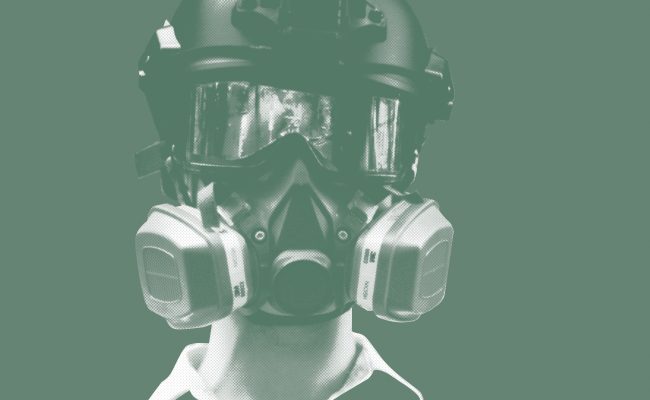The reverse beep of the delivery truck and the thunderous wobble of plate steel signalled the arrival of a delivery.
Circling the truck bed, the Machinist counted the number of sheets of Corten and tightly-wrapped bundles of solid steel bar using his finger in the air, pointing to each one in turn.
He squinted at his list again. A series of indistinct lines drawn on a soft surface, perhaps on his thigh with a blunt pencil piercing the paper.
The truck driver directed him on the forklift with a series of hand gestures and hollers till the tynes gently cradled the quivering weight to the ground.
They swapped paperwork and chatted with their engines running.
The truck driver asked the Machinist if he’d ever fixed a cracked sump bolthole on a motorbike.
‘I’ve done a couple. I’d strip it and turn it over for a weld and rethread and then install a larger sump plug.’
‘Are you up for doing it?’
‘I can’t guarantee it’ll hold but I could give it a shot.’
‘What’s a good day?’
‘Wednesday?’
‘I’m free. I’ll bring it in.’
After the truck left the Machinist scanned the workshop for an area to store the new materials. For 18 months, he had been holding off calling the scrapper to collect his turnings and cut-offs, instead collecting and storing them in 44-gallon drums in the workshop till prices improved. Now they were taking up much-needed space in front of the hydraulic shear.
Screeching the forklift tynes into the drum lifter, he removed each bin and placed them on the platform scales. He had to lick his thumb and rub the worn display panel to read the numbers which he jotted down in a note pad before taking each barrel outside. He lined them up against the cyclone fence in the car park then manoeuvred the plate steel and rods into the workshop. He began returning the more valuable copper and brass barrels to the workshop to be locked up that night.
While he was returning to grab another barrel, a gold 350SL Mercedes coupé pulled up alongside the drums, blocking the path of the forklift.
The coupé was immaculate. It looked as though it had been driven off the factory floor that morning. The Machinist turned off the forklift and could hear the effortless whisper of the V8 gently idling. Its worth was easily more than the value of every piece of machinery in his shop combined. The driver’s crisp pastel blue shirt and grey sports jacket, gold watch and delicately-framed glasses exuded a wispy, easy charm and the Machinist began to think he could be looking at a contract with a very wealthy client.
He climbed down from the forklift and wiped his palm on his overalls to prepare to shake the man’s hand. Ten years it had been, at least, since he’d acquired any big contracts or been able to offer consistent work to employees. He dared to envision engaging a young apprentice, a strong young person to help with the heavy lifting and take over shop duties while he focused on administration and maintenance.
He imagined the workshop alive with activity again, perhaps manufacturing prefabricated components for a large commercial building project, something that could give them years of work. He looked around the carbon-dark warehouse and wished he’d made time to clean up. The weld slag and dust of oxy-cutters, grinding discs and mill-scale had for years been swept from paths through the workshop by the shuffling of booted feet and had built up in dark swales under the hydraulic shear and lathes. He often thought about revealing the shiny grey and green enamel surfaces of these machines, which had been almost completely covered in soot, but could never justify the time it would take. It had been years since he’d organised the assorted circular dies which spilled out from under a dark grease-soaked hessian cloth in the corner or used the rack above the welding bench to hang his assorted clamps and fasteners, instead pushing them aside to use the bench, cramming them in messy piles against the wall.
The Machinist could imagine how with consistent income he could fix the bandsaw, which had been lying idle for months, waiting till he could afford a new belt and blade. He could buy a new bench-grinder disc for sharpening the tungsten tips for his tig welder, which had worn down till he had to reach dangerously over the sharpening guide. He could stock the near-empty shelves of his supply cupboard with cut-off, flap-discs and wire-wheels and buy a new bearing for the lathe, which had begun to screech with neglect. With the time a solid contract afforded him, he’d pull it apart and clean and grease it as good as new.
His excitement grew as he watched the man open the door of the coupé but when he saw the tanned bare ankle extend below the door, sporting a dark brown leather moccasin-style boating shoe, he began to fear it was all a fantasy. The man exited his car and the Machinist saw he was wearing tan khaki shorts above the knee, which the Machinist recognised immediately as the casual attire of the perpetual weekender and the idle rich. He lost hope completely when he realised the man was extending his hand, not to shake his, but to show him the bolt cradled in his palm.
‘It’s from a fully restored late Victorian double. A classic Eastlake,’ the man said as he handed the machinist the short black bolt. The Machinist rolled it in his hand, feeling its weight, studying its colour against his permanently stained palms. He held it up between his swollen fingers, squinting at it from different angles but couldn’t find anything unusual about it. It was a generic steel bolt. Common as dirt.
‘Well, what do you think? Can you make one?’ the man insisted.
‘It’s possible. But it will take a couple of days. I’ll have to order some hexagonal bar, lathe it, temper the steel then cut the thread.’
‘Very good. Wednesday it is.’ The man smiled and turned quickly to his car. Cautiously, he reversed into the street, narrowed with parked trucks, as the Machinist threw the bolt into a cluster of stationery and paperwork under the counter.
Early on Wednesday morning, the truck driver rode into the warehouse on a 2008 KLR650. The Machinist crouched painfully on his hands and knees and inspected the hairline crack extending from the sump bolt. The oil was relatively new, still clear and golden, forming a drip like a polished stone on the edge of the bolt.
‘Over-tightened during the last service. Hope you didn’t pay someone for that?’
The driver shook his head.
‘If I did, they’d be fixing it. Self-inflicted I’m afraid.’
The Machinist rummaged on the shelf above the pipe-clamp bench, his knuckles clicking dusty cans, pushing to the back to retrieve a bottle of white vinegar and a filthy tub of Vaseline. Dipping his finger in the Vaseline, he made a circle on the crankcase and poured a small amount of vinegar into the centre of it. With the Vaseline holding the surface tension of the vinegar he observed no whitening or fizzing, which indicated pure aluminium. He wanted to be sure he didn’t cause a fire or destroy the engine from welding magnesium alloy.
The Machinist gave the truck driver an empty plastic 5L oil bottle, a knife and a 22mm spanner. The driver cut out the side of the bottle and put it under the sump. The sump-bolt slipped from his fingers as he loosened the last of the thread and it fell into the still-hot stream of oil filling the container. He awkwardly dipped his fingers into the oil to retrieve it while the Machinist fetched a rag for him to wipe his hand.
The Machinist left the truck driver to begin stripping the bike, removing the tank, the seat, battery and fairings while he gathered the tools for the job. He rolled the tig and grinder over on the bottom shelf of a small bench attached to casters whose dry bearings were embedded with steel dust, making them screech and seize against the floor. On top of the tig sat his tattered denim welding hood, soft leather welding gloves (smooth and black at the fingers) and face shield stippled by years of errant hot metal beads.
Like a surgeon preparing for an operation, he placed on the bench a sump-oil preserved wooden box of taps and dies as well as drill bits, thread gauges, slide callipers, filler rods, sandpaper, hand files, a piece of cloth, a length of wire, solvent and a small tub of sour-smelling lard.
The Machinist settled himself onto an adjustable stool within arm’s reach of the bench and with the bike between his outstretched knees. Using the slide callipers, he measured the new sump bolt and matched it to an appropriate drill bit. He drilled out the hole and the slow rotation of the razor-sharp bit created a long silver curl of metal. He firmly attached the rag to the wire and inserted it into the hole to prevent grinder dust from entering the sump. The wire was to retrieve the rag if it fell through. Using the grinder, he cut into the crack, creating a valley for the weld material. After removing the rag and wire he cleaned the area with the solvent, careful to run his cloth-covered finger inside the hole to collect any wayward aluminium dust.
He slipped into his gloves and put on his welding hood and mask, tightening the ratchet toggle at the back to fit his head. Flicking the helmet down with a rough nod, he began feeding the rod into the white-hot star of light created at the tungsten tip of the welder. Satisfied he had adequately filled the crack, he waited a few minutes for the weld to cool. He reinserted the rag and wire and used the file to carefully flatten the weld, finishing with the sandpaper to create a smooth surface.
Using the thread gauge to match the new sump bolt, he searched through the wooden box for the right-sized tap. He cracked the grey surface of the lard and rubbed a chunk between his fingers to melt it before working it into the cutting-thread. Feeding the tap into the hole, he worked it carefully into the soft metal till it turned easily then backed it out carefully. After cleaning the area with solvent, he screwed in the new sump bolt and tightened it with the 22ml spanner.
Once the welding was done, he excused himself to make a phone call to the scrapper.
‘Copper prices are not great now, and brass isn’t much better, but I can offer you a good price. Above standard. Alley, iron and stainless are also still in the pits,’ the scrapper informed him.
The Machinist thought for a moment while they both breathed heavily into their receivers. He was aware of current values and thought the scrapper wasn’t being truthful about how soft prices were. Copper and brass were not the best but decent.
‘I’ve got copper, brass, braziery, steel, alley and steely alley…. but I’ll leave the stainless turnings and cut-offs for now. What’s your best offer on the copper?’
‘Three dollars seventy.’
‘I think you can do better with where prices are heading, and I’ll use you later for the stainless if I can get a deal on this today.’
They shared another word-less, breath-full exchange while the scrapper considered his offer and the Machinist considered which yard he’d call next.
It was a hostile symbiosis he shared with the several scrappers in the area. It hurt to let scrap go for anything less than the best price. Once he arranged a pickup, it unnervingly snapped into place like a magnet to iron. The scrap truck would swiftly arrive and nimbly empty his bins with a disconcerting efficiency and enthusiasm, which made him worry he should have waited, haggled more or gone with another company. Invariably, in the months following, he carefully watched the market prices rise and fall, obsessively calculating his losses and gains and a bad or ill-timed deal ached like an injury.
‘Okay, I’ll do you four dollars twenty on turnings and four dollars on the cuttings, as long as you send that stainless my way.’
The scrapper was yielding but firm on an agreement concerning the stainless as it represented leverage for a better deal down the road.
‘Right-o. They’ll be ready in the yard, usual place.’
As the Machinist hung up the phone he watched from the window of his office as the gold Mercedes pulled up, smooth as oil, in the driveway.
The Machinist used the time it took for the man to cross the car park and enter the office to search under the counter for the bolt. He quickly slipped it into his pocket. He pretended not to remember the job the man was there to pick up.
‘The bolt for the Eastlake?’
‘Oh yes, the bolt. Yep, yep, yep. That’s all done. Just wait and I’ll grab it.’
Entering the workshop from the side door of the office, the Machinist walked to a large metal locker and pulled out and shut several drawers of assorted fastenings. After comparing the bolt to several of similar size, he managed to find one that was identical. It was unused with a nut attached, which he removed, and after vigorously scrubbing it on his overalls, he sprayed both bolts with WD40, wrapped them in a rag and walked back to the office.
‘Apart from the patina of the older bolt, it’s identical!’ The man raised them up to the light, one in each hand, comparing them. ‘We should all lament the death of manufacturing in this country!’ The man beamed at the Machinist with misplaced awe.
The Machinist stapled an EFTPOS docket to an A4-sized itemised receipt for charges of $5 for materials and $20 for labour and handed it to the man. He noticed the man was still smiling as he eased the car into gear.
Returning to the workshop, the Machinist helped the truck driver set the bike on its wheels and while he put the remaining parts of the bike back together, the Machinist packed up his tools. He dragged the tig bench back across the floor and with a renewed desire to keep his benches tidy he returned each tool to its respective shelf, drawer, hook or hollow. Then he rolled himself a cigarette.
Once the bike was completely reassembled, they turned it on and let it warm up. They got down on their hands and knees and watched as the heat of the engine thinned the oil and a golden drop began to form around the new sump bolt. Eventually, it gathered enough weight to drop to the ground. There it formed an imperfect golden orb drawing silvery metal dust across its glossy surface. They couldn’t look at it. Both turned away in disgust and the Machinist knew he couldn’t, in good conscience, charge the truck driver for the job.
Read the rest of Overland 245
If you enjoyed this piece, buy the issue




